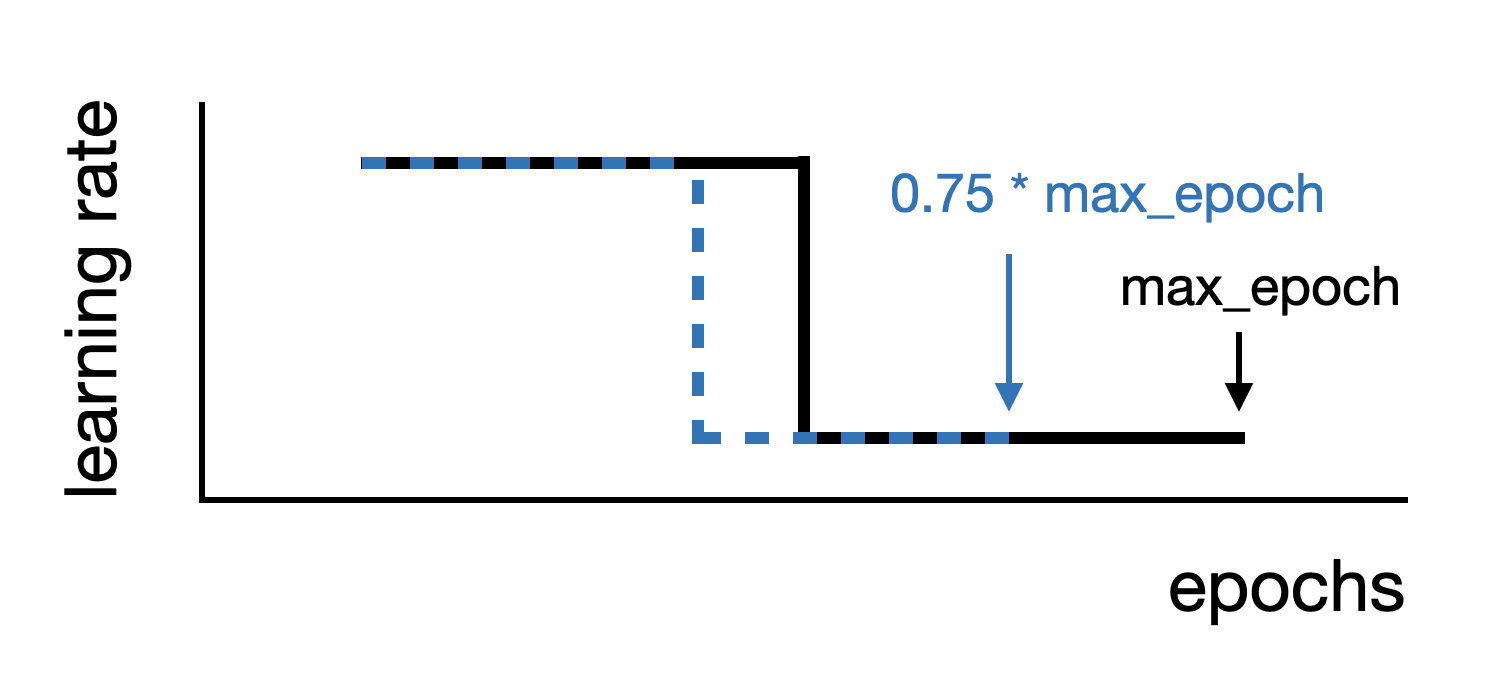Scale Schedule

Tags: Best Practice, Speedup
TL;DR
Scale Schedule changes the number of training steps by a dilation factor and dilating learning rate changes accordingly. Doing so varies the training budget, making it possible to explore tradeoffs between cost (measured in time or money) and the quality of the final model.
Attribution
The number of training steps to perform is an important hyperparameter to tune when developing a model. This technique appears implicitly throughout the deep learning literature. One example of a systematic study of this approach is the scan-SGD technique in *How Important is Importance Sampling for Deep Budgeted Training* by Eric Arazo, Diego Ortega, Paul Albert, Noel O’Connor, and Kevin McGuinness. Posted to OpenReview in 2020.
Hyperparameters
ratio- The ratio of the scaled learning rate schedule to the full learning rate schedule. For example, a ratio of 0.8 would train for 80% as many steps as the original schedule.method- Whether to scale the number of trainingepochsperformed or the number of trainingsamplesused.samplesis not currently supported.
Example Effects
Changing the length of training will affect the final accuracy of the model. For example, training ResNet-50 on ImageNet for the standard schedule in the composer library leads to final validation accuracy of 76.6%, while using scale schedule with a ratio of 0.5 leads to final validation accuracy of 75.6%. Training for longer can lead to diminishing returns or even overfitting and worse validation accuracy. In general, the cost of training is proportional to the length of training when using scale schedule (assuming all other techniques, such as progressive resizing, have their schedules scaled accordingly).
Implementation Details
Scale schedule is only called once at the beginning of training, and it alters the max_epochs stored in the composer.State() object.
The state update looks something like:
new_max_epochs = int(state.max_epochs * ratio)
state.max_epochs = new_max_epochs
Scale schedule is currently only possible with the following learning rate schedulers:
StepLR, MultiStepLR, ExponentialLR, CosineAnnealingLR, CosineAnnealingWarmRestarts,
Scale schedule does not scale the warmup, if it is included at the beginning of the learning rate schedule.
If other methods specify absolute steps during training, these are not affected by scale schedule.
Suggested Hyperparameters
The default scale schedule ratio is 1.0. For a standard maximum number of epochs (these will differ depending on the task), scaling down the learning rate schedule will lead to a monotonic decrease in accuracy. Increasing the scale schedule ratio will often improve the accuracy up to a plateau, although this leads to longer training time and added cost.
Composability
As general rule, scale schedule can be applied in conjunction with any method. If other methods also perform actions according to a schedule, it is important to modify their schedules to coincide with the altered number of epochs.
Code
- class composer.algorithms.scale_schedule.ScaleSchedule(ratio: float, method: str = 'epoch')[source]
Makes the learning rate schedule take a different number of epochs.
Training for less time is a strong baseline approach to speeding up training, provided that the training still gets through the entire learning rate schedule. E.g., training for half as long often yields little accuracy degredation, provided that the learning rate schedule is rescaled to take half as long as well. In contrast, if the schedule is not rescaled, training for half as long would mean simply stopping halfway through the training curve, which does reach nearly as high an accuracy.
To see the difference, consider training for half as long using a cosine annealing learning rate schedule. If the schedule is not rescaled, training ends while the learning rate is still ~0.5. If the schedule is rescaled, training ends after passing through the full cosine curve, at a learning rate orders of .01 or smaller.
- Parameters
ratio – The factor by which to scale the duration of the schedule. E.g., 0.5 makes the schedule take half as many epochs and 2.0 makes it take twice as many epochs.
method – Currently only
"epochs"is supported.
- Raises
ValueError – Raised during
applyifscheduleris not supported byscale_scheduler().ValueError – Raised during
applyif the resulting number of epochs after scaling the learning rate schedule is zero.NotImplementedError – Raised during
applyifmethod != "epochs".
See also
- apply(event: composer.core.event.Event, state: composer.core.state.State, logger: composer.core.logging.logger.Logger) Optional[int][source]
Rescales the number of epochs spanned by state’s learning rate schedule.
- Raises
ValueError – If
scheduleris not supported byscale_scheduler().ValueError – If the resulting number of epochs after scaling the learning rate schedule is zero.
NotImplementedError – If
self.method == 'samples'.
- match(event: composer.core.event.Event, state: composer.core.state.State) bool[source]
Run on Event.TRAINING_START
- Parameters
event (
Event) – The current event.state (
State) – The current state.
- Returns
bool – True if this algorithm should run no
- composer.algorithms.scale_schedule.scale_scheduler(scheduler: torch.optim.lr_scheduler._LRScheduler, ssr: float, orig_max_epochs: Optional[int] = None)[source]
Makes a learning rate schedule take a different number of epochs.
See
ScaleSchedulefor more information.- Parameters
scheduler –
A learning rate schedule object. Must be one of:
torch.optim.lr_scheduler.CosineAnnealingLRtorch.optim.lr_scheduler.CosineAnnealingWarmRestartstorch.optim.lr_scheduler.ExponentialLRtorch.optim.lr_scheduler.MultiStepLRtorch.optim.lr_scheduler.StepLR
ssr – the factor by which to scale the duration of the schedule. E.g., 0.5 makes the schedule take half as many epochs and 2.0 makes it take twice as many epochs.
orig_max_epochs – the current number of epochs spanned by
scheduler. Used along withssrto determine the new number of epochsschedulershould span.
- Raises
ValueError – If
scheduleris not an instance of one of the above types.